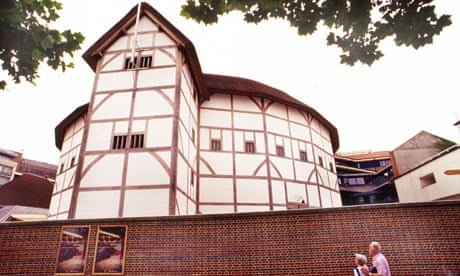If you walk from Tate Modern on London's Bankside towards Blackfriars bridge there is a modern office block on Hopton Street. In Shakespeare's time it boasted the biggest theatre in town, holding 3,000 people – larger than any West End venue today. It wasn't the Globe, the Rose or the Hope, all 500 yards farther east down the river. It was the Swan. This venue has long been familiar to Shakespeare buffs – a drawing by a Dutch visitor of its stage is the only picture extant of what an Elizabethan stage actually looked like – but largely unknown to the thousands who walk by each day. There is not even a plaque to commemorate it, though there is a sign reading "Falcon Point", to mark the spot where, facing the Swan, stood the Falcon Inn – where Shakespeare, Ben Jonson and other actors and writers would almost certainly have caroused.
In Stratford, Shakespeare's birthplace, you can't move for memorabilia, but in London – where he spent his working life – he is curiously neglected. The one shining exception is the reconstructed Globe, for which we have to thank the dogged determination of an American, the actor Sam Wanamaker.
It was mainly for this reason that I have tried to employ modern technology, in the form of a mobile phone, to remind us of these buried memories of the playwright. An app I've just published for the iPhone/iPad and iPod Touch – called for obvious reasons Shakespeare's London – uses the phone's geo-positioning function to tell you how many yards you are from, for instance, the taverns he surreptitiously mentioned in his plays (such as "the Elephant" in Twelfth Night), the Silver Street house he lodged in with a Huguenot wigmaker or the numerous theatres where he acted or where his plays were performed. If you click on an icon on the map, up comes a commentary plus reproductions of old prints and maps.
The number of active theatres in early-modern London, nearly all with links to Shakespeare, was amazing considering they were supported by a city with barely 200,000 inhabitants. Assuming reasonable occupancy rates, it would appear that a substantial proportion of the capital's population went to plays each month at these three places alone. And these "dedicated" playhouses were not the only theatres. When I first became interested in the subject some years ago, I had no idea of the existence of the Blackfriars theatre, east of New Bridge Street, which I passed every day on my way to work at the Guardian's Farringdon offices and where Shakespeare's company performed in the evenings and during the winter when the Globe was closed.
Nor did I know much about of the string of inn and theatres along Gracechurch Street and Bishopsgate, leading on to Shoreditch, home to the Theatre and the Curtain, where Shakespeare's plays were first performed when he came to London. Nowadays they have only one plaque between them, which you can see if you stretch your neck and peer above Foxton's estate agents in Curtain Road, Shoreditch. If you go around to the back you'll see a blue door behind which recent excavations uncovered remains of the Theatre, the first dedicated venue with its own company to be built in London.
The prize for the first permanent theatre of any kind in Britain probably belongs to the Red Lion in Mile End, not far from the Boar's Head in Whitechapel (not to be confused with Falstaff's watering hole of the same name in Eastcheap). One of the biggest surprises was to find that Shakespeare's troupe acted at Newington Butts in June 1592 – exactly where Elephant and Castle now is. It seems clear that, in Shakespeare's time, going to the theatre was seen – by people of all classes – as the social equivalent of going to the football, watching EastEnders, drinking and clubbing, all rolled into one.

Comments (…)
Sign in or create your Guardian account to join the discussion